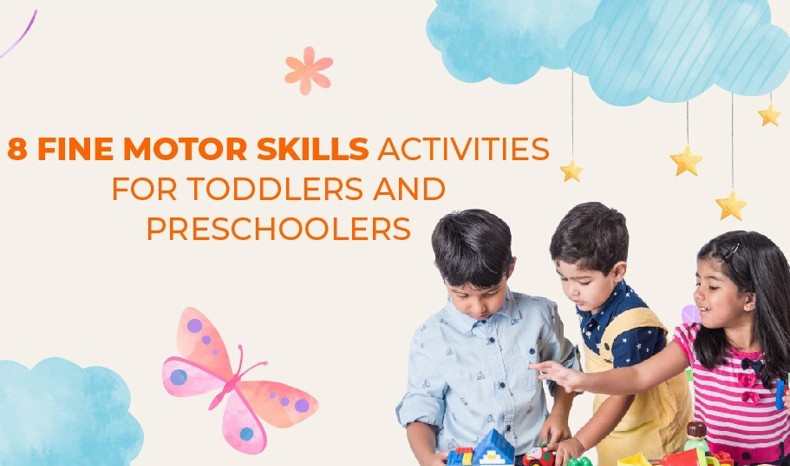8 Fine Motor Skills Activities for Toddlers and Preschoolers
Fine motor skills are essential to the development of a child toward their independence. It usually uses fine muscular movements within the hands and fingers for small participation in simple daily living activities, such as writing, eating, and dressing. Fine motor development during early childhood enhances coordination but also effectively prepares for academics and self-sufficiency.
The article discusses eight interesting fine motor skills activities for preschoolers and toddlers, with a combination of fun and practice.
What Are Fine Motor Skills?
Fine motor skills are typically seen in coordinated actions performed by various small muscles in the hand and finger. It is characterized by movements, usually done in activities requiring considerable accuracy, like picking up small items, coloring, and buttoning. Such skills require eye-hand coordination, which refers to visual perception working synchronously with physical movement.
An important milestone is mastering fine motor skills, which include learning to write, making shapes, and using utensils correctly.
Why Are Fine Motor Skills Activities Important?
When children become involved in activities that promote the development of their fine motor skills, they gain many advantages:
- Improved Hand-Eye Coordination: Bead-threading is an example of a precision activity that synchronizes hand movements to visual focus.
- Enhanced Focus and Concentration: Repetitive and detailed tasks build patience and attention to detail.
- Preparation for Writing and School Tasks: The development of fingers in terms of strength and control is necessary to hold a pencil and form letters.
Toddlers and preschoolers can learn to cope with doing things for themselves by including fine motor skills activities in daily routines.
8 Fine Motor Skills Activities for Toddlers and Preschoolers
Here are very few simple yet resourceful activities to enhance fine motor skills in young children:
1. Cutting Shapes
Provide your child with child-safe scissors and paper that has shapes already drawn on it. Encourage your child to follow the lines while cutting.
- What It Develops: Precision, hand-eye coordination, and finger strength.
- Tips: Learn straight lines first and then develop into curves and complex shapes later.
2. Bead Threading
Using large, colorful beads and strings, thread the beads with your child one at a time.
- What It Develops: Two-handed actions where it needs dexterity and concentration.
- Tips: For beginners, use pipe cleaners instead of strings for rigidity.
3. Sticker Art
Provide your child with an assortment of stickers and let them peel and stick the stickers onto a plain piece of paper.
- What It Develops: Pincer grip, hand control, and creativity.
- Tips: Choose easy-to-peel stickers for younger toddlers.
4. Finger Painting
Support your small one in making creative paintings solely using their fingers and non-toxic colors.
- What It Develops: Tactile awareness, creativity, and hand strength.
- Tips: Don aprons and get some washable paints for easy cleanup afterward.
5. Playdough Sculpting
Provide your child with playdough and tools like cookie cutters or rolling pins to make shapes and forms with them.
- What It Develops: Finger strength, creativity, and spatial awareness.
- Tips: Motivate children to roll balls or form snakes to develop finger dexterity.
6. Button Sorting
After providing a series of buttons in various sizes and colors, ask your child to sort them size-wise, shape-wise, or color-wise.
- What It Develops: Categorization skills, pincer grasp, and hand-eye coordination.
- Tips: Use a muffin tray for sorting so that it is more engaging.
7. Pom-Pom Drop
Get a container with a pretty small opening and let your child use tongs or tweezers to drop pom-poms into it.
- What It Develops: Grip strength, precision, and hand stability.
- Tips: Start with a big hole and then gradually reduce it to make the task harder.
8. Egg Carton Sorting
With an empty egg carton, ask your child to put little objects such as marbles or even beads inside each of the compartments.
- What It Develops: Finger control, coordination, and focus.
- Tips: Add to the educational value by including counting or sorting objects by color.
Conclusion
Fine motor skills activities do not only help develop a child to have control over muscle movements; it's also good for enhancing creativity, problem-solving, and even independence. Keeping your child engaged regularly in these activities would help boost their development significantly.
We at PlayNLearn, provide countless play ideas and resources to help parents create a fun and educational environment for their children. Explore our offerings to unlock your child’s full potential!
FAQs
1. What are examples of fine motor skills in toddlers?
Examples of this would be picking up small objects, stacking blocks, drawing with crayons, and turning pages of books.
2. How do fine motor skills affect school readiness?
The development of fine motor skills prepares children for writing, cutting, and other hand-controlled and coordinated tasks in the classroom.
3. How can I make fine motor skills activities fun for my child?
Make use of colorful materials, bring stories, and make it highly engaging by converting the activities into games to keep your child engaged.
4. What’s the difference between fine motor skills and gross motor skills?
Small muscle movements (such as movements of the fingers) are involved in fine motor skills while gross motor skills (large muscle groups) are for running or jumping.
5. How often should I engage my child in these activities?
Consistent practice, even for just 10-15 minutes a day, can improve fine motor skills considerably with time.






